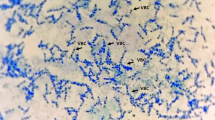Summary
Cultured tissue cells from lepidopteran and dipteran sources displayed an order-specific response to entomocidal protein from crystals ofBacillus thuringiensis. Protein isolated from crystals ofB. thuringiensis subsp.kurstaki was effective against cells of the spruce budworm (Choristoneura fumiferana) and the tobacco hornworm (Manduca sexta), but was inactive against both mosquito cell lines tested (Aedes aegypti andAnopheles gambiae). Conversely, protein from inclusion bodies ofB. thuringiensis subsp.israelensis was fully active only against the mosquito cell lines but displayed reduced (four- to seven-fold) toxicity for the lepidopteran cell lines. One exception to this pattern of specificity was observed with aPlodia interpunctella cell line, which failed to respond to either crystal protein preparation. The moth toxin was stable at 4° C for months, whereas the mosquito toxin was susceptible to proteolytic degradation and was unstable for periods longer than 2 wk.
Similar content being viewed by others
References
Heimpel, A. M.; Angus, T. A. The site of action of crystalliferous bacteria in Lepidopteran larvae. J. Insect. Pathol. 1: 152–170; 1959.
Goldberg, L. J.; Margalt, J. A bacterial spore demonstrating rapid larvicidal activity againstAnopheles sergentii, Uranotaenia unguicultata, Culex univitattus, Aedes aegypti, andCulex pipiens. Mosq. News 37:355–358; 1977.
Tyrell, D. J.; Davidson, L. I.; Bulla, L. A., Jr.; Ramoska, W. A. Toxicity of parasporal crystals ofBacillus thuringiensis subspisraelensis to mosquitos. Appl. Environ. Microbiol. 38: 656–658; 1979.
Tyrell, D. J.; Bulla, L. A., Jr.; Andrews, R. E., Jr.; Kramer, K. J.; Davidson, L. I.; Nordin, P. Comparative biochemistry of entomocidal parasporal crystals of selectedBacillus thuringiensis strains. J. Bacteriol. 145: 1052–1062; 1981.
Ignoffo, C. M.; Couch, T. L.; Garcia, C.; Kroha, M. J. Relative activity ofBacillus thuringiensis var.kurstaki andB. thuringiensis var.israelensis against larvae ofAedes aegypti, Culex quinquefasciatus, Trichoplusia ni, Heliothis zea, andHeliothis virescens. J. Econ. Entomol. 74: 218–222; 1981.
Murphy, D. W.; Sohi, S. S.; Fast, P. G.Bacillus thuringiensis enzyme-digested delta endotoxin: Effect on cultured insect cells. Science 194: 954–956; 1976.
Johnson, D. E. Toxicity ofBcillus thuringiensis entomocidal protein toward cultured insect tissue. J. Invertebr. Pathol. 38: 94–101; 1981.
Johnson, D. E.; Freedman, B. Toxicity ofBacillus thuringiensis Spo− Cr+ mutants for the European corn borer,Ostrinia nubilalis. Appl. Environ. Microbiol. 42: 385–387; 1981.
Thomas, W. E.; Ellar, D. J.Bacillus thuringiensis varisraelensis crystal δ-endotoxin: Effects on insect and mammalian cellsin vitro andin vivo. J. Cell Sci. 60: 181–197; 1983.
Sohi, S. S.In vitro cultivation of larval tissues ofChoristoneura fumiferana (Clemens) (Lepidoptera: Torticidae). 1971 Proc. 3rd Int. Colloq. Invertebr. Tissue Culture; Smolenice. Bratislava, Czechoslovakia: Publishing House of the Slovak Academy of Sciences; 1973: 75–92.
Eide, P. E.; Caldwell, J. M.; Marks, E. P. Establishment of two cell lines from embryonic tissue of the tobacco hornworm,Manduca sexta (L.). In Vitro 11: 395–399; 1975.
Lynn, D. E.; Oberlander, H. Development of cell lines from imaginal wing discs of Lepidoptera. In Vitro 17: 208; 1981.
Yunker, C. E.; Vaughn, J. L.; Cory, J. Adaptation of a cell line (Grace'sAntherea cells) to a medium free of insect hemolymph. Science 155: 1565–1566; 1967.
Singh, K. R. P. Cell cultures from larvae ofAedes albopictus (Skuse) andAedes aegypti (L.). Curr. Sci. 36: 506–508; 1967.
Mitsuhashi, J.; Maramorosch, K. Leaf hopper tissue culture: Embryonic, nymphal and imaginal tissues from aseptic insects. Contrib. Boyce Thompson Inst. 22: 435–460; 1964.
Varma, M. G. R.; Pudney, M. The growth and serial passage of cell lines fromAedes aegypti (L.) larvae in different media. J. Med. Entomol. 6: 432–439; 1969.
Bulla, L. A., Jr.; Kramer, K. J.; Cox, D. J.; Jones, B. L.; Davidson, L. I.; Lookhart, G. L. Purification and characterization of the entomocidal protoxin ofBacillus thuringiensis. J. Biol. Chem. 256: 3000–3004; 1981.
Chestukhina, G. G.; Kostina, L. I.; Mikhailova, A. L.; Tyurin, S. A.; Klepikova, F. S.; Stepanov, V. M. The main features ofBacillus thuringiensis δ-endotoxin molecular structure. Arch. Microbiol. 132: 159–162; 1982.
Johnson, D. E. Selection for resistance toBacillus thuringiensis δ-endotoxin in an insect cell line (Choristoneura fumiferana). Experientia. In press.
Nishiitsutsuji-Uwo, J.; Endo, Y.; Himeno, M. Effects ofBacillus thuringiensis δ-endotoxin on insect and mammalian cellsin vitro. Appl. Entomol. Zool. 15: 133–139; 1980.
McGaughey, W. H. Response ofPlodia interpunctella andEphestia cautella larvae to spores and parasporal crystals ofBacillus thuringiensis. J. Econ. Entomol. 71: 687–688; 1978.
Johnson, D. E.; McGaughey, M. H. Insecticidal activity of spore-free mutants ofBacillus thuringiensis against the Indianmeal moth and almond moth. J. Invertebr. Pathol. In press.
Author information
Authors and Affiliations
Rights and permissions
About this article
Cite this article
Johnson, D.E., Davidson, L.I. Specificity of cultured insect tissue cells for bioassay of entomocidal protein fromBacillus thuringiensis . In Vitro 20, 66–70 (1984). https://doi.org/10.1007/BF02633334
Received:
Accepted:
Issue Date:
DOI: https://doi.org/10.1007/BF02633334




